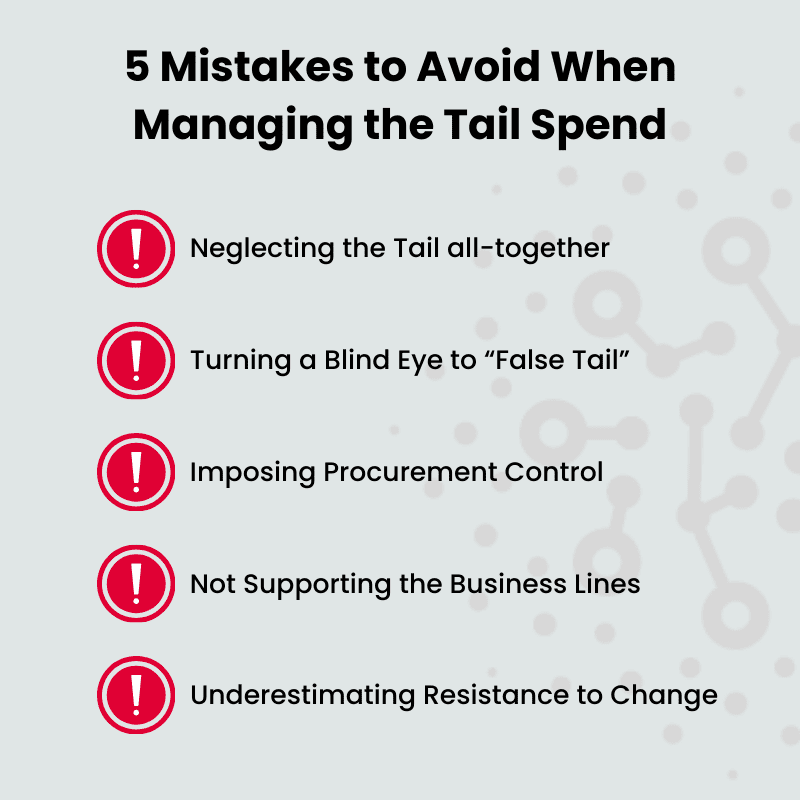We all know the story. It’s a tale as old as time in the corporate landscape; a company goes about its operations for years, blissfully unaware of the intricacies of their spending habits until one fateful day, they delve into the depth of their tail spend in consulting.
Managing in the tail spend in consulting suddenly becomes paramount. Suddenly, the alarm bells ring, and the realization dawns — something must be done. A panorama of missed opportunities, unoptimized strategies, and scattered expenditures reveal themselves, laying bare the vital need for a structured approach to managing tail spend.
In procurement, the ‘tail’ often goes unnoticed, hidden in the shadows of grander projects deemed more ‘strategic’ and ‘essential.’ Yet, this so-called small change, which is very often scattered across various departments, largely uncategorized and sometimes even documented fancifully in the ERP, harbors a potential that is anything but insignificant.
It’s a realm where procurement generally enters at the eleventh hour, hurriedly asked to issue a purchase order without having the backdrop of the needs and the strategic alignments.
So how exactly do we navigate this intricate pathway of managing the tail spend in consulting without depriving business lines of their vital prerogatives and yet ensuring a streamlined process that promises efficiency and savings?
In this article, we unravel the common mistakes companies stumble upon in managing the tail spend in consulting and shine a light on strategies to effectively tame this ‘unruly beast’ with diligence, foresight, and strategic acumen.
1. Neglecting the Tail Altogether
Many organizations mistakenly perceive tail spend as insignificant, relegating it to the sidelines of their strategic focus.
This underestimation stems from a lack of visibility into the scattered nature of such expenses and a common misconception that smaller spends don’t require as much scrutiny or strategy.
It’s easy to lose sight of the accumulative impact of these seemingly minor expenses, especially when overshadowed by larger, high-profile projects and contracts.
However, managing in the tail spend in consulting is a critical aspect of optimizing organizational expenditures and ensuring operational efficiency.
Unfortunately, many organizations tend to neglect the tail altogether, failing to recognize its significance. This neglect can have detrimental consequences, including missed savings opportunities and operational inefficiencies.
Consequences:
By neglecting the tail, companies unwittingly pass up on potential savings and the opportunity to optimize their operations. Over time, these overlooked expenses can accumulate, representing a sizeable chunk of unnecessary expenditure.
Beyond the immediate financial implications, neglecting the tail can also lead to operational inefficiencies. For instance, the company might miss out on volume-based discounts or find themselves dealing with a plethora of suppliers without gaining the advantages of consolidation.
There’s also an increased risk of non-compliance with internal policies and external regulations, given the lack of oversight. Ultimately, what seems like a benign oversight can escalate into substantial financial losses and operational hiccups.
Why it Happens:
Consulting spend is frequently scattered across departments, often without a consolidated view at the company level. Consulting projects, seen as the exclusive domain of top leadership, tend to elude the standard oversight of procurement.
Consequently, procurement usually gets brought into the picture at the eleventh hour. Furthermore, the way consulting services are recorded on ERPs lacks consistency, sometimes bordering on the whimsical.
This fragmented and haphazard approach creates an environment where the tail spend is easy to neglect.
Solution:
Spend Analysis: Begin with a robust spend analysis to unravel the full scope of the tail. Delve deep into departmental spends and unearth potential areas for savings.
Taxonomy for Consulting Services: Establish a clear and standardized taxonomy for consulting services. This will ensure that all consulting projects, regardless of department, are categorized consistently and accurately within the system. Make sure all teams are well-informed and trained on how to utilize the taxonomy and record projects accurately.
Digital Dashboard: Implement a digital dashboard for real-time oversight of consulting expenses. With this, you won’t have to wait till the end of a fiscal period to review and course-correct. A real-time dashboard empowers proactive decision-making, ensuring that potential pitfalls are addressed before they morph into significant issues.
Recognizing and rectifying the oversight of neglecting tail spend can help companies to not only save on expenditures but also streamline their operations for better efficiency and compliance.
2. Turning a Blind Eye to the ‘False Tail’
Managing the tail spend in consulting, which includes addressing the issue of the ‘false tail,’ is crucial for optimizing an organization’s expenses and operations.
The ‘false tail’ represents a deceptive area of spend that may appear as multiple smaller transactions on the surface but is, in fact, part of a more substantial cumulative expense.
Many organizations, whether due to a lack of awareness or the complexity of tracking such spends, mistakenly categorize these as genuine tail spend, creating a significant challenge in efficient expense management.
Consequences:
Neglecting to identify and manage the ‘false tail’ in consulting has far-reaching consequences. It not only undermines an organization’s potential for cost savings but also hinders the ability to subject these disguised larger expenses to the scrutiny and strategic management they require.
This oversight results in missed opportunities for securing bulk discounts, negotiating better terms, or exploring alternative solutions that might offer superior value. Moreover, the failure to recognize the ‘false tail’ can lead to fragmentation in project management within the consulting domain.
Similar consulting projects might be initiated across different departments, leading to inconsistencies in approach and outcomes. This lack of a unified consulting strategy not only inflates costs but also jeopardizes the quality of the consulting results.
Why it Happens:
The ‘false tail’ emerges from practices such as fragmenting projects to bypass approval thresholds, or due to lack of visibility where similar projects are commissioned by different departments. Without a consolidated view or a robust tracking mechanism, these disguised expenses can easily be misinterpreted as mere tail spend in consulting.
Solution:
Internal Communication: Foster better communication across various business units and departments. Sharing insights and strategies can help in identifying overlapping or fragmented projects that contribute to the ‘false tail’.
Centralized Tracking Tools: Implement a comprehensive, centralized tracking system that offers visibility into all consulting projects across the organization. Such a system can help in quickly identifying spends that may seem scattered but are essentially part of a larger cumulative expense.
Regular Audits: Periodically review and audit consulting projects to ensure that there aren’t any disguised spends going unnoticed. This can also help in identifying patterns and behaviors leading to the emergence of a ‘false tail’.
By accurately identifying and strategically managing the ‘false tail’, organizations can harness the potential of significant savings, streamline their consulting projects, and ensure consistent quality across the board.

3. Imposing Absolute Procurement Control
A common pitfall in the quest to streamline consulting expenses is to centralize all decisions within the procurement department, depriving individual units of their purchasing autonomy.
While the intention might be to instill strict guidelines and consistency, this rigid approach can inadvertently throttle agility and delay vital projects.
Consequences:
By mandating that every purchase gets routed through procurement, organizations can introduce undue lags into the decision-making process. Especially in the dynamic world of consulting, where timely responses are often pivotal, these delays can result in lost opportunities or jeopardized outcomes.
What’s more, departments, which have a nuanced understanding of their specific needs, might feel the stringent controls handicap their ability to get the best solutions.
Another critical consideration is that the procurement team, already stretched thin, might not have the bandwidth to handle every request meticulously. They might lack the specialized knowledge about the consulting services needed, leading to cursory or inadequate evaluations.
Consequently, this can mean two things: botched procurement processes or significant decision-making delays.
Over time, this restrictive approach can lead to mounting frustration, diminishing trust in the procurement process, and might even tempt departments to seek covert workarounds.
Why it Happens:
This error usually originates from a well-intentioned aim to consolidate, monitor, and bring uniformity to consulting spends.
Organizations, wary of fragmentation and inconsistency, may presume that pooling purchasing decisions is the answer. While centralized control has its merits, its overzealous application can inadvertently backfire.
Solution:
Autonomy with Oversight: Grant departments the liberty to make certain decisions independently, but within an established framework. This harmonizes agility with control, ensuring alignment with overarching goals without causing unnecessary bottlenecks.
Guided Sourcing: Rather than leaving departments guessing or imposing iron-fisted controls, furnish them with a roster of vetted, preferred suppliers. This safeguards quality and can also lead to better pricing, while affording departments some latitude in choice.
Regular Check-ins and Feedback Loops: Regularly liaise with different departments, grasping their unique needs and challenges. This bilateral communication can aid in finetuning the procurement process, making it more supportive and in sync with departmental goals.
By judiciously balancing control with flexibility, organizations can craft a procurement process that’s efficient, strategic, and aligned with the multifaceted needs of its departments.
4. Not Supporting Business Lines in Their Procurement Endeavors
A prevalent error is leaving individual departments to handle the sourcing of consulting services without centralized guidance.
Lacking the necessary tools, guidelines, and expertise, these departments often feel isolated in their procurement efforts, resulting in decisions that might not be in the best interest of the broader organization.
Consequences:
Without centralized support or tools, departments might end up sourcing from a multitude of different consulting suppliers. This not only leads to a lack of standardization but can also result in missed opportunities for bulk discounts or consolidated services.
The isolated nature of such purchases means that departments might be commissioning multiple consulting projects on similar or related topics, missing out on potential synergies and leading to duplicated efforts.
Besides, with no standardized procurement protocol, departments might lean heavily on personal relationships or subjective criteria when choosing consultants. This can compromise the quality of the consulting service and even introduce potential conflicts of interest.
Why it Happens:
Departments often have a profound understanding of their immediate needs and the nature of their business. However, this doesn’t necessarily translate into expertise in procurement or awareness of the prevailing procurement policies.
They might be well-versed in what they need, but not in how best to obtain it, or what organizational rules and best practices should guide their purchasing decisions.
Solution:
Digital Platforms: Provide digital platforms that streamline the procurement process, providing real-time insights into expenses and the broader consulting market.
Best Practices & Knowledge Resources: Arm your business lines with comprehensive guides detailing the current procurement policies and best practices in sourcing consulting services. This ensures decisions that align with organizational strategies and adhere to established protocols.
Vetted Providers: Build a list of pre-vetted providers. This fast-tracks the selection process and ensures that chosen consultants meet a baseline quality and compatibility threshold.
Dedicated Point of Contact: Designate a unique point of contact for consulting needs, ensuring a consistent and expert touchpoint for all departmental procurement inquiries.
By proactively supporting departments and promoting a collaborative approach to procurement, organizations can enjoy the benefits of both departmental insights and centralized coordination, achieving optimal value and results.
5. Underestimating Resistance to Change
Change, especially when it entails added layers of oversight and perceived restrictions, can often be met with skepticism or even resistance.
A classic misstep when introducing new procurement strategies for managing the tail spend in consulting is underestimating the inherent human tendency to resist changes to the status quo.
This is especially true when these changes seem to add bureaucracy or reduce departmental autonomy.
Consequences:
Reduced Buy-in: Resistance can lead to reduced buy-in from crucial stakeholders, thereby affecting the successful rollout and implementation of the new strategies.
Operational Disruptions: Pushback can manifest in the form of operational disruptions, with departments seeking workarounds or even reverting to old habits instead of adhering to the new guidelines.
Wasted Resources: Significant resources might be expended in crafting and launching a new strategy, only for it to be rendered ineffective due to non-compliance or active resistance.
Why it Happens:
Employees and managers, particularly those accustomed to certain levels of freedom and discretion in their roles, might view new procurement processes as threats to their autonomy.
They might also harbor concerns about the added complexity these processes introduce, or even question the necessity for change in the first place, especially if the rationale behind it hasn’t been adequately communicated.
Solution:
Change Management: Recognize that introducing new strategies isn’t just a procedural shift; it’s also a cultural one. This requires robust change management practices to facilitate understanding and acceptance.
Engaging Key Managers Early: By involving influential figures from the onset, you can harness their influence to rally their teams behind the new approach.
Crafting a Compelling Narrative: Clearly articulate why the change is essential. Showcase the drawbacks of the current approach and how the new strategy addresses them. Emphasize benefits, such as potential savings and increased operational efficiency.
Smooth Transitioning: Anticipate potential points of friction and address them proactively. This might include training sessions, Q&A forums, or even piloting the strategy in select departments before a full-scale rollout.
By acknowledging the human side of change and actively managing the transition, organizations can mitigate resistance and set the stage for successful implementation. After all, a strategy is only as effective as its execution, and its execution hinges on the people tasked with carrying it out.
Conclusion – Managing the Tail Spend in Consulting
Managing the tail spend in consulting is more than just a strategic move; it’s a dance between careful oversight and appreciating the nuances of individual stakeholder needs.
It’s evident that the challenges are multifaceted, from scattered spends, misidentifications, and the tug-of-war between autonomy and control. Yet, the key is not to view these challenges as roadblocks but as indicators of where focus is needed.
Mistakes are bound to happen, especially when treading unfamiliar territory. However, by recognizing these common pitfalls and proactively seeking solutions, organizations can turn potential setbacks into stepping stones towards consulting procurement excellence.
But remember, the essence of effective management isn’t just in identifying problems but in crafting and implementing solutions that resonate with the organization’s culture and objectives.
The world of consulting procurement is intricate, but with the right approach, the promise of operational efficiency and substantial savings is well within reach.
So, as organizations journey forward, let them do so with a clear vision, an open mind, and the tools to make informed, strategic decisions.
After all, in the realm of business, it’s the meticulous attention to the “small change” that often paves the way to larger victories.
managing the tail spend in consulting managing the tail spend in consulting managing the tail spend in consulting managing the tail spend in consulting
managing the tail spend in consulting managing the tail spend in consulting managing the tail spend in consulting managing the tail spend in consulting
managing the tail spend in consulting managing the tail spend in consulting managing the tail spend in consulting managing the tail spend in consulting

How Consource Can Help?
Consource offers a smarter, more efficient way to manage the tail by providing real-time visibility into your consulting spend, identifying who is spending on what and with whom, ensuring that no purchase ever slips through the cracks. The outcome? Cost reduction and optimization of your buy.








0 Comments